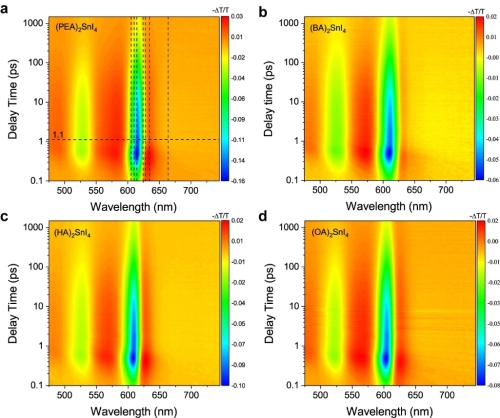Recently, researchers from Shanghai Institute of Optics and Fine Mechanics (SIOM), Chinese Academy of Sciences (CAS), and Shanghai University of Electric Power have made significant progress in the physics of exciton ultrafast relaxation dynamics in two-dimensional (2D) Sn-based halide perovskites. The researchers have revealed the luminescence mechanism of 2D Sn-based halide perovskites to confirm that the scattering via deformation potential by defects is the main scattering mechanism for excitons, dominating the physical process of exciton interband relaxation. The paper was published online in Nature Communications on January 10, 2022.
With the strong space quantum confinement effect and the weak dielectric shielding effect, the exciton binding energy of 2D layered perovskites can be up to several hundred meV at room temperature, which is an ideal material for studying exciton ultrafast physical processes. Compared with 2D Pb-based layered halide perovskites, 2D Sn-based layered halide perovskites is a non-toxic and environment-friendly luminescent material.
However, the luminescence efficiency of light-emitting devices based on 2D Sn-based layered halide perovskites is much lower than that of light-emitting devices based on 2D Pb-based layered halide perovskites.
The present results suggest that scatterings via deformation potential by acoustic and homopolar optical phonons are the main scattering mechanisms for excitons in 2D Pb-based halide perovskites, however, the luminescence mechanism in 2D Sn-based halide perovskites is still highly controversial. The controversy focuses on which of defect scattering and phonon scattering dominates the exciton recombination process. The main reason for the controversy is that the lattice structure of 2D layered halide perovskites is too soft to lead to the strong exciton-optical phonon coupling effect, which easily makes the intrinsic self-trapped exciton (STE) states to affect the exciton recombination process.
In addition, the intrinsic self-trapping state can easily couple with permanent defects to form the extrinsic self-trapping state in Sn-based halide perovskites. At present, it has been no work to identify which scattering process dominates the exciton recombination in 2D Sn-based layered halide perovskites.
In response to this controversial problem, the researchers have independently designed and built a transient absorption spectroscopy system with temperature field regulation function and obtained the national invention patent authorization. By combining experimental studies of temperature-dependent transient absorption spectroscopy, cation regulation engineering of 2D perovskites with physical models of exciton scattering, the researchers further revealed the mechanism of luminescence of two-dimensional Sn-based perovskites, i.e., the deformation caused by defect scattering dominates the exciton recombination process and affects its luminescence efficiency, which is significantly different from that of 2D Pb-based perovskites.
On the other hand, the results show that the exciton relaxation process in 2D Sn-based perovskites can be divided into three components: (I) the sub-picosecond lifetime relaxation component, which is a competition between the defect-trapped exciton process and the hot exciton-induced bandgap reformation process; (II) the lifetime ~100 ps relaxation component, the interband radiation recombination process is mainly affected by the deformation potential scattering by charged defects, not the exciton splitting into free carriers; thus, the relaxation rate increases with the decrease in temperature and defect state density; (III) the nano-second lifetime relaxation component, which is a defect-assisted exciton recombination process, which involves the radiative recombination induced by relatively shallow extrinsic STE states and the non-radiative recombination processes are induced by deep defects.
The researchers’ results reveal the complex contributions of significant materials that improve the luminous efficiency of Sn-based perovskites and provide directional guidance for further improving their luminous properties, that is, a more precise structural design is needed for 2D Sn-based perovskites to reduce the electron–phonon scattering intensity and reduce Sn2+ oxidation.

Figure 1. (a) Crystal structures of four different types of 2D Sn-based perovskites engineered by cation regulation. (b) Schematic diagram of the exciton relaxation process of 2D Sn-based perovskite. (Image by SIOM)

Figure 2. False-color 2D transient absorption spectroscopy mapping of the four perovskites: a (PEA)2SnI4, b (BA)2SnI4, c (HA)2SnI4, and d (OA)2SnI4 thin films. (Image by SIOM)
Article website:
https://doi.org/10.1038/s41467-021-27663-0
Contact:
WU Xiufeng
General Administrative Office
Shanghai Institute of Optics and Fine Mechanics, CAS
Email: xfwu@siom.ac.cn
Web: http://english.siom.cas.cn/